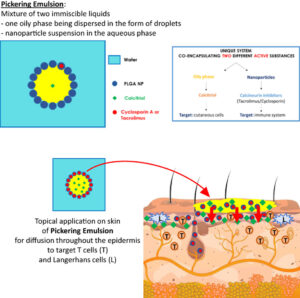 JID Innovations. Volume 4, Issue 4, 100273, July 2024. Maxime Sintès, Petra Kovjenic, Liasmine Haine (Hablal), Kevin Serror, Mohamed Beladjine, Véronique Parietti (Montcuquet), Marine Delagrange, Bertrand Ducos, Jean-David Bouaziz, David Boccara, Maurice Mimoun, Armand Bensussan, Martine Bagot, Nicolas Huang, Laurence Michel.
JID Innovations. Volume 4, Issue 4, 100273, July 2024. Maxime Sintès, Petra Kovjenic, Liasmine Haine (Hablal), Kevin Serror, Mohamed Beladjine, Véronique Parietti (Montcuquet), Marine Delagrange, Bertrand Ducos, Jean-David Bouaziz, David Boccara, Maurice Mimoun, Armand Bensussan, Martine Bagot, Nicolas Huang, Laurence Michel.
https://www.jidinnovations.org/action/showPdf?pii=S2667-0267%2824%2900020-1
Résumé
Psoriasis is an inflammatory skin disease characterized by epidermal and immune dysfunctions. Although efficient, current topical treatments display adverse effects, including skin atrophy and burning sensation, leading to poor patient adherence. To overcome these downsides, pickering emulsions were formulated in which the calcitriol-containing dispersed phase was stabilized with either cyclosporin A– or tacrolimus-loaded poly(lactic-co-glycolic) acid nanoparticles. This study aimed to investigate their biological effects on lymphocytes and epidermal cells and their effectiveness in an imiquimod-induced psoriasis-like mouse model. Results showed that both emulsions significantly inhibited nuclear factor of activated T cell translocation in T lymphocytes as well as their IL-2 production, cell activation, and proliferation. In keratinocytes, inhibition of nuclear factor of activated T cell translocation decreased the production of IL-8 and TNF-α. Topical application of emulsions over skin biopsies ex vivo showed accumulation of rhodamin B–coupled poly(lactic-co-glycolic) acid nanoparticles throughout the epidermis by immunofluorescence and significantly decreased the antigen-presenting capacity of Langerhans cells in relation to a reduced expression of activation markers CD40, CD86, and HLA-DR. Using an imiquimod-induced psoriasis model in vivo, pickering emulsions significantly alleviated psoriasiform lesions potentially attributed to the decreased cutaneous expression of T-cell markers, proinflammatory cytokines, chemokines, and specific epidermal cell genes. Altogether, pickering emulsion might be a very efficient formulation for treating inflammatory dermatoses.